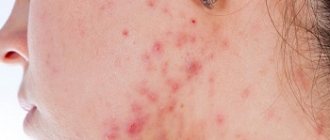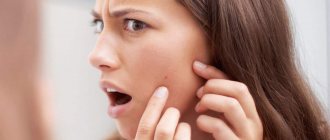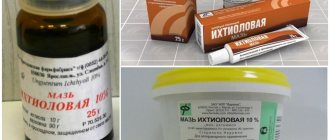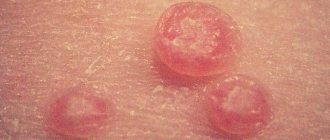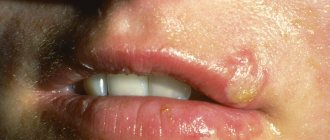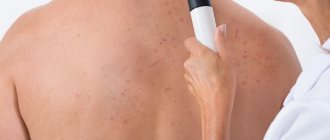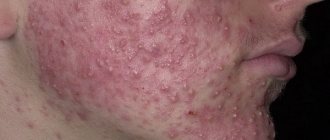Medical terminology
Most often, acne vulgaris (acne, acne vulgaris) is one of the types of acne that occurs against the background of seborrhea.
Seborrhea is a common dermatological disease, which is expressed in increased greasiness of the skin, large fat content of the epidermis of the back, face, shoulders and décolleté, which leads to inflammatory processes in these places.
Why do acne most often appear on the upper torso and face? The thing is that an increased number of sebaceous glands per 1 square centimeter is concentrated here. And if in other areas of the skin this figure is 100, then here it will be 900.
Thus, acne vulgaris is characterized by the following features:
- Frequent relapses. If the disease manifested itself in adolescence or young adulthood, it may occur again at 30 or 40 years of age.
- It often manifests itself between the ages of 11 and 20 years, but may have a later or, conversely, earlier onset.
- Rashes mainly appear in areas where there are many sebaceous glands.
- In addition to acne and pimples, redness, flaking and itching may occur.
Since acne is a disease that is treated by a dermatologist, it has its own ICD code and it looks like this - L70.0.
What acne vulgaris is is now clear. It remains to find out what causes the disease and how to get rid of it.
Treating acne at home
Traditional medicine offers various remedies for acne on the face and body. Their common disadvantage is that they are all quite troublesome to use.
- Aloe. This plant actively fights infection and inflammation. For the procedure, you need to squeeze out aloe juice and soak gauze folded in four layers with it. Apply a compress to the affected area. Aloe draws out pus even from deep acne, but you just need to carry out at least 40 daily procedures.
- Propolis tincture. At night, you need to lubricate problem areas with alcohol tincture of propolis. In the morning, it is recommended to cleanse the skin with lotion. The course of treatment is 30 days.
- Cottage cheese. Fermented milk products are an excellent remedy against acne. Soft homemade cottage cheese helps remove subcutaneous acne and spots from them. The compress should be prepared as follows. Place a 0.5 cm layer of cottage cheese on a napkin or gauze. The density and thickness of the napkin should be such that it absorbs excess liquid from the cottage cheese. When applying a compress to the acne area, you need to cover it with a film, and then strengthen and insulate it with a scarf or some kind of comfortable bandage. Keep the compress for at least an hour, but it is better to leave it overnight. At first, about a week, you need to do this every day. Then you can give your skin a little rest.
- Lemon. Its bactericidal properties are known to everyone. How to treat acne vulgaris with this fruit? You can make compresses with lemon juice for 10-15 minutes. In addition to suppressing infection, the acid partially dissolves sebaceous plugs and dead cells, removes age spots and refreshes the skin. You can simply wipe your face with a slice of lemon twice a day after washing your face. During this treatment, you should use sunscreen and avoid prolonged exposure to bright sun. Citric acid makes the skin more sensitive to ultraviolet radiation.
Why do acne vulgaris appear?
Before starting treatment, you need to find out what is the cause of the disease. Without this, the use of even modern drugs may be ineffective and useless.
The main cause of acne vulgaris in adolescents is considered to be the onset of puberty.
At this time, the level of androgen hormones in the blood increases, and this happens not only in boys, but also in girls.
This hormone leads to increased secretion of the sebaceous glands, as a result of which sebum becomes thick and viscous, clogs the skin ducts, and pathogenic microorganisms begin to multiply here, which causes redness, inflammation, peeling and itching of the skin.
However, adolescence is not the only reason for the appearance of pimples and blackheads on the face. No less common provoking factors include:
- Diseases of the digestive system in the acute stage, for example, gastritis.
- Genetic predisposition.
- Taking certain medications.
- Constant consumption of sweets, soda, chips.
- Diseases of the endocrine system.
- Excessive sweating.
- Hormonal disorders that occur in the female body during pregnancy, as well as after childbirth and when feeding a newborn with breast milk.
- Gynecological diseases.
- Weakened immunity.
- Smoking.
- Frequent consumption of alcoholic beverages.
- Prolonged exposure to the sun.
- Work in dusty conditions and at elevated ambient temperatures.
- Emotional stress.
- Improper body hygiene or its complete absence.
- Excessive application of cosmetics to the face.
As you can see, there are many reasons for the appearance of common acne. It is difficult to understand exactly why you have acne. Here you simply cannot do without consulting a doctor. and only after identifying the cause can we begin to eliminate it and subsequent treatment.
How does acne vulgaris form?
The entire process of formation of acne vulgaris on the skin can be divided into several stages. And every pimple that appears on the face, shoulders or back will definitely go away.
The first step is to begin to increase sebum production. This secret not only becomes abundant, but it changes its structure. And if earlier sebum easily passed from the sebaceous gland to the skin and performed its protective function, now it is not able to leave the gland because it is too thick.
The second step - the sebaceous gland begins to stretch and noticeably increase in size, as more and more sebum accumulates here. This leads to the formation of closed comedones, which are located under the skin.
The third step is the addition of infection. Propionibacterium acnes, which is present on the skin of all people and is completely harmless under normal conditions, becomes dangerous when inflammation begins to develop. It is this microbe that leads to inflammation, which occurs in the stretched sebaceous gland with a large content of sebum, which cannot flow out of it.
The fourth step is the appearance of acne vulgaris on the skin. Gradually, there are more and more pimples, and it is no longer possible to get rid of them using the usual skin care products, for example, gel or foam for washing.
What it is
Acne vulgaris is a condition in which tiny plugs form in the pores of a person's skin. These plugs are made up of sebum as well as tiny exfoliated skin cells.
The disease is called “acne,” and medical scientists call acne vulgar, that is, ordinary.
There are two types of acne:
- closed;
- open.
Closed ones are usually white, the plugs in them are not visible. These are small white bumps on the surface of the skin.
Open blackheads are characterized by a dark color, and the plugs themselves in the pores of the skin are clearly visible. They are formed due to the secretion of sebum. The dark color of acne is given by a special substance – melanin.
Acne vulgaris occurs on the nose of almost all people. Most often, these white and black dots are found on the forehead, as well as the cheeks and chin.
Do not confuse acne with pimples. After all, with acne there is no inflammation inside or around the plug. Whereas a pimple is an inflamed tubercle consisting of a hair follicle and a sebaceous gland.
What are they?
Acne vulgaris is one disease with different manifestations. Pimples and blackheads can look different in this condition.
Closed comedones or whiteheads
The most common manifestation of acne vulgaris should be considered closed comedones or whiteheads. These are small papules measuring 1 or 2 mm that may not be noticeable under normal conditions, but become visible when the skin is stretched.
When pressing on such a comedone, its contents come out with great difficulty. they often become inflamed and form a real pimple.
Open comedones or blackheads
Open comedones are so-called blackheads. They appear when oxygen penetrates into the site of the stretched sebaceous gland and the oxidation process begins. The gland itself and the hair follicle are clogged with a sebaceous plug. When pressed, the contents easily appear on the surface of the skin.
Open comedones rarely become inflamed. A natural scrub made from ground oatmeal helps get rid of them.
Pimples
A pimple is an inflamed comedon. They can be represented by papules, pustules, cysts and nodules. This is a real inflammatory process, which is difficult to fight on your own.
Acne comes in many forms, but there are some that pose a real health threat.
Conglobate acne - tends to merge, spreads over a large area of the body, is large in size and literally disfigures the appearance.
Indurative acne is hard to the touch, leaving behind deep scars and scars that are not so easy to fight.
Phlegmonous acne - filled with pus, can increase in size, cause general symptoms of intoxication (fever, headache) and cause blood poisoning if left untreated.
All rashes on the face that occur with acne vulgaris can be divided into inflammatory and non-inflammatory.
Non-inflammatory elements are comedones, both open and closed. All others are called inflammatory.
How to remove acne spots?
Finding a way to get rid of acne is half the battle. A scar or pigment spot remains at the site of the pimple, which can last up to a year. Correct and timely treatment of acne vulgaris reduces these unpleasant phenomena. If the stain still remains, homemade masks will help get rid of it faster.
Recipe 1. Make a paste of cinnamon powder and honey mixed in equal parts. Apply the composition only to stains and leave for 20 minutes.
Recipe 2. You can wipe stains with a mixture of rosemary, clove, mint and lavender essential oils. To do this, you need to dissolve 2 drops of rosemary oil in a teaspoon of vegetable oil, and take the rest 1 drop each.
Recipe 3: Cucumber juice will help lighten your skin. You can apply a cucumber pulp mask to the spots for 10-15 minutes.
Stages (severity) of acne vulgaris
Acne vulgaris, like many other diseases, occurs in 4 stages of its development. Each of them has its own characteristics and symptoms.
Stage 1 (severity)
On the body, and most often this is the face, there are small amounts of open comedones (blackheads). Papules may also appear in the form of small elevations above the skin, but without pus. There is slight redness.
The disease apparently has the minimal possible symptoms and can be cured without the use of medications.
Stage 2 (severity)
There are more pimples on the skin, and now they are not only comedones, but also noticeable ulcers. New elements of acne appear almost every day. The skin becomes noticeably painful, itching and peeling appear.
It is important to remember that in the second stage you can still get rid of acne without any consequences and using drugs only for external use - ointments, creams, gels, lotions.
Stage 3 (severity)
At this stage, there are about 50 pimples and ulcers on the skin. they all look like inflamed, ugly formations that can give rise to many inferiority complexes.
In addition to ulcers, cysts filled with pus also appear on the skin. The skin is constantly inflamed, painful to the touch and there is severe redness. Inflammation affects not only the upper layer of the epidermis, but also deeper layers.
Stage 4 (severity)
The whole face is covered with ulcers. The papules become large and any touch to the skin causes severe pain. Despite the fact that the pustules are very large, they can also increase in size due to the pus that accumulates in them.
Even full treatment cannot eliminate the formation of scars and cicatrices. Therefore, you should not bring your skin condition to stage 4 of acne vulgaris. Not only are the inflammations themselves very difficult to treat, but getting rid of post-acne can be extremely difficult.
Diagnostics
Acne vulgaris, which in medicine is coded according to the ICD as L70.0. is a disease. Therefore, the first thing to do is to consult a dermatologist and get a referral for those tests that the doctor considers necessary to make an accurate diagnosis.
Most often, the doctor writes out directions for:
- Determination of testosterone levels in the blood.
- Determination of prolactin levels in the body.
- Determination of dehydroepiandrosterone sulfate, as well as dehydroepiandrosterone, is mandatory.
- Determination of the amount of globulins.
- For girls and women - lutein-stimulating hormone, as well as follicular-type hormone.
A dermatologist may also advise you to visit a gynecologist and get a referral from him to analyze alpha-hydroxyprogesterone and cortisol in the blood. this is necessary in order to exclude such a dangerous disease as polycystic ovary syndrome.
A dermatologist can also rinse or scrape the skin to determine which microbe is causing this inflammation.
If necessary, the doctor may prescribe other tests - ultrasound, general blood test, general urine test.
General recommendations
To prevent the progression of the disease, you must adhere to the following recommendations:
- maintain a low carbohydrate diet,
- eat fresh fruits and vegetables containing fiber,
- clean the skin using mild detergents (no more than twice a day),
- Do not squeeze out blackheads to prevent bacterial infection.
With a complicated course of the disease and improper treatment, severe defects of the skin remain: scars, depressions, irregularities, spots. Eliminating such a negative consequence is difficult and sometimes impossible. Therefore, it is better to start acne therapy at an early stage of its manifestation and carry out it under the supervision of a doctor.
Treatment
Acne vulgaris or acne vulgaris is a disease that requires a mandatory visit to the doctor. the course of treatment, the set of medications and the duration of treatment will depend on the stage of the disease.
Treatment of mild acne vulgaris
At the initial stage of development, the doctor will advise the use of cosmetics based on salicylic acid, sulfur or other antiseptics.
Typically, on the prescription sheet, the doctor may write:
- Any product from the Klerasil line that is perfect for cleansing the skin and getting rid of the initial stage of inflammation and redness.
- Oxy-5 lotion based on benzoyl peroxide. This is one of the most popular remedies for treating mild acne. It is easy to use, has a minimum of contraindications, is not an antibiotic and can be used until complete recovery.
- Avone Clearskin is one of the popular series of cosmetic medicinal products for relieving teenagers of acne and pimples at the initial stage. It fights well against comedones.
- Skinoren cream is an affordable and popular remedy for the treatment of early stage acne. It contains azelaic acid, which destroys microorganisms that cause inflammation and reduces the formation of sebum.
Other popular drugs for treating the initial stage of acne include cindol mash, infusion of calendula or celandine for washing, and a solution of salicylic acid for topical application only to areas of inflammation.
Treatment of moderate acne vulgaris
In addition to antibiotic-based medications, patients are recommended to use retinoic acid-based medications. For example, an excellent drug from this group of mild action can be called retin-a.
Among antibiotics, doctors recommend choosing ointments and gels based on:
- Doxycycline.
- Tetracycline.
- Erythromycin.
- Clindamycin.
- Lincomycin.
We cannot refuse the methods of traditional medicine. But still, the first place should no longer be cosmetics and not herbal infusions and decoctions. Namely medicines from the pharmacy.
Salicylic ointment can be applied to the area, but do not touch healthy skin.
For large pimples, it is recommended to apply compresses from Vishnevsky ointment.
Another proven cure for moderate acne vulgaris is rozamet.
A month after the start of treatment, it is necessary to evaluate the condition of the skin and, if necessary, replace medications that turned out to be useless. Under no circumstances should you self-medicate, as it will only worsen the skin condition, which will cause scars to appear.
Treatment of severe acne vulgaris
Severe acne vulgaris is a dangerous disease that sometimes has to be treated even in a hospital. In this case, not only preparations for application to the skin are used. But also those that need to be taken orally (capsules, tablets).
Girls may be offered a course of oral contraceptives, for example, this may be the drug Jess.
One of the most powerful drugs for the treatment of acne at this stage is isotretinoin, which is called abroad as roaccutane. However, the drug has many contraindications, so it should be used only under the strict supervision of a doctor.
Drawing conclusions
Acne vulgaris is often called a disease of adolescents. And indeed. This acne occurs before the age of 25 and then goes away. After all, the hormonal background begins to normalize and remains stable. And only in 10% of the adult population, acne, which is associated with hormones, does not go away for a longer time.
Diagnostics is an important step and should not be skipped. If necessary, you may need to consult not only a dermatologist, but also a gynecologist or urologist, an adolescent pediatrician, a cosmetologist, or an endocrinologist.
Under no circumstances should self-medication be allowed. It can cause many side effects and lead to pimples and acne being replaced by necrosis, scars and scars.
Author - Anna Mikhailova, dermatologist-cosmetologist of the first category, specialist at the Academy of Scientific Beauty. Especially for the site “Treating Acne”.
